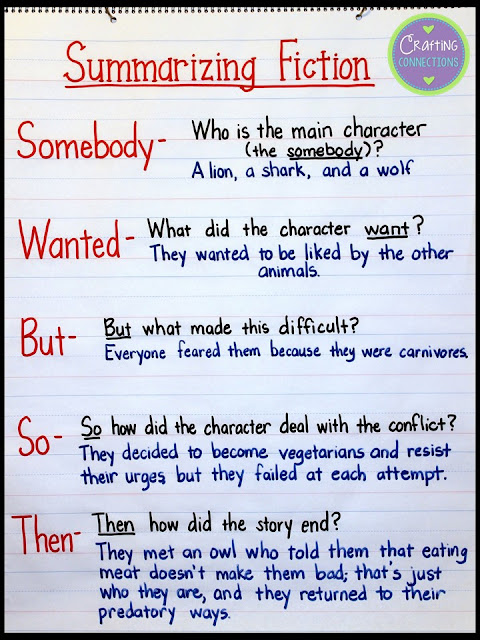My Personal Experience with the SWBST Strategy
I first learned of this strategy when I attended a teacher-inservice meeting several years ago. Initially, I was intrigued. The examples shared by the presenter were strong summaries! Plus, I liked the idea of having a prescribed "formula" where you just plug in each element. However, when I took this approach back to my classroom and prepared to use it with students, I struggled with it... a lot. Two problems kept holding me back from embracing this strategy. First, I realized that when I used the SWBST strategy, I had to leave out some pretty significant details. Yes, I knew summaries were supposed to be short, but I kept thinking that some details were just too important to skip! Second, I kept running into examples where the SWBST "formula" did not work, and this left me feeling frustrated and confused. Needless to say, I ultimately decided against using the "Somebody Wanted But So Then" strategy, and opted instead for a different approach.Recently, however, I read a book (Reading Nonfiction by Kylene Beers and Robert E. Probst) where they devoted an entire section of their book to a version of the SWBST strategy. It renewed my interest in the approach. As I dug deeper, I realized that building a summary based on the words "Somebody Wanted But So Then" did not provide quite enough support for me. Once I found some anchor questions to accompany each word, I began to experience a lot more success when I used the strategy.
As I was reacquainting myself with this approach, a teacher just happened to contact me, and ask if I would ever consider making a set of summarizing fiction tri-folds using the Somebody Wanted But So Then" summarizing strategy. It felt like fate at the time, and I decided that I needed to give it a try. Much to my surprise, I was able to overcome the two obstacles that blocked me several years earlier. I realized that I needed to "get over" my love for details and that details should be must be eliminated from summaries. As for the times when the SWBST strategy fell short, I eventually came to the conclusion that at those times, students can start by applying the SWBST strategy, but that it's also okay to add in critical information that might not fit into the "formula". (If you would like to view an example of how I address the notion of adding critical information that does not fit the SWBST formula with my students, check out the preview of my Summarizing PowerPoint.)
It took a few years, but now I can say that I am comfortable with the "Somebody Wanted But Then So" summarizing strategy. In fact, I now look forward to teaching this topic to students!
A Mentor Text Lesson
This lesson is designed to occur fairly early in your summarizing fiction unit. Personally, I would introduce the concept of summarizing fiction by using my PowerPoint on Day 1, and this lesson would happen on Day 2. At the beginning of class, I would ask the students to recall the name of the summarizing strategy we learned yesterday. Then, I would ask students to recall the anchor question that goes with each element. As students share, I would write their answers on the anchor chart, leaving space between each section. Therefore, when we are done reviewing, this is what the anchor chart would look like:
Next, I would read aloud Carnivores, by Aaron Reynolds. This is a fun picture book that appeals to upper elementary students because of the author's clever humor. The three main characters feel hurt and left out because the rest of the animal kingdom fears them, so they try to change their carnivorous ways.
 |
| Click HERE to check this book out on Amazon. |
Once the anchor questions are answered, writing the summary is a breeze!
If you happen to be searching for resources you can use when teaching students to write a summary, feel free to check out my Summarizing Fiction Bundle!
Thanks for stopping by!
~Deb
Pin for future reference:















This really helped me avoid some of the pitfalls you encountered. I think another point worth making is that this really is designed for full texts, rather than sections of stories. If looking for a summarising method for chapters (e.g. for book club discussions), this would not be it. I think a combination of think-alouds and gradual release can achieve this latter aim.
ReplyDeleteThanks for sharing!